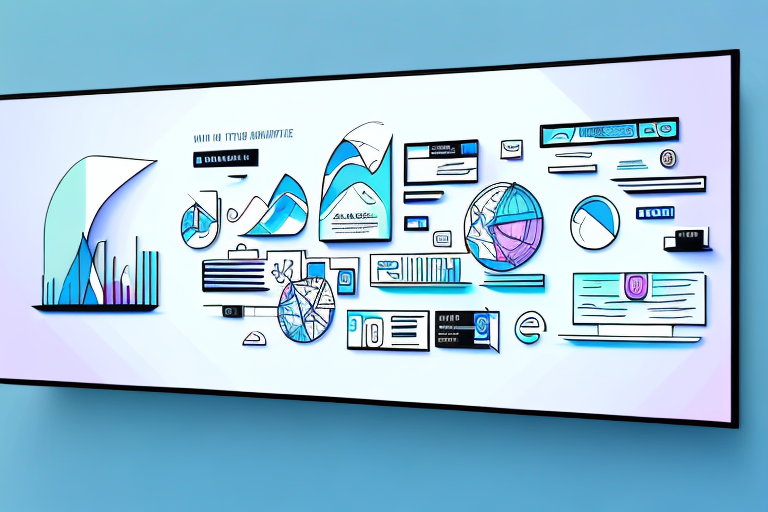Designing Effective Digital Signage for Maximum Impact
In today’s fast-paced world, businesses are under intense pressure to communicate with consumers quickly and effectively. One way to do this is through the use of digital signage. It’s a powerful tool that can help you convey messages to a wide audience with ease and efficiency. However, to be successful, it must be thoughtfully designed and strategically placed. In this article, we’ll explore how to create digital signage that is both visually striking and informative, and which ultimately delivers maximum impact on your target audience.
Understanding the Importance of Digital Signage
Before we dive into the specifics of designing effective digital signage, let’s first examine why it’s such an important tool for businesses. In today’s fast-paced world, customers are constantly bombarded with information and advertisements. Digital signage can help businesses cut through the noise and deliver real-time information to customers in a way that is both engaging and memorable.
One of the key benefits of digital signage is its ability to enhance brand recognition. By using dynamic and interactive displays, businesses can create a more immersive and memorable experience for customers. This can help to build brand loyalty and increase the likelihood of repeat business.
Another benefit of digital signage is its ability to create a more engaging in-store experience. By using eye-catching displays and interactive features, businesses can capture customers’ attention and keep them engaged for longer periods of time. This can lead to increased sales and a more positive customer experience overall.
The Evolution of Digital Signage
Digital signage has come a long way from its early days when it consisted mostly of static images and scrolling text. Today’s digital signage is characterized by dynamic and interactive displays that can be managed remotely. The technology has become more sophisticated and affordable over time, making it an accessible and valuable tool for businesses of all sizes.
One of the key advancements in digital signage technology has been the ability to use data and analytics to create more targeted and effective displays. By analyzing customer behavior and preferences, businesses can create displays that are more likely to capture customers’ attention and drive sales.
Benefits of Digital Signage for Businesses
The benefits of digital signage for businesses are many. It can help drive sales, promote brand awareness and create a more immersive customer experience. It can also reduce perceived wait times and increase the likelihood of impulse purchases. By using digital signage, businesses can communicate with customers in a way that is efficient, cost-effective and eye-catching.
Another benefit of digital signage is its ability to adapt to changing circumstances and promotions. Unlike traditional signage, digital displays can be easily updated and changed to reflect new products, promotions or events. This can help businesses stay relevant and competitive in a fast-changing marketplace.
In conclusion, digital signage is a powerful tool for businesses looking to enhance their brand recognition, engage customers and drive sales. By using dynamic and interactive displays, businesses can create a more immersive and memorable experience for customers, leading to increased loyalty and repeat business.
Identifying Your Target Audience
One of the most critical things you must do when designing digital signage is to identify your audience. Understanding your audience’s demographics and psychographics will help you tailor your content and design to their preferences and needs.
When it comes to demographics, age is a crucial factor to consider. Different age groups have different interests and preferences. For example, younger audiences may be more interested in technology and social media, while older audiences may prefer more traditional forms of advertising. Gender is another important factor, as it can influence the type of content that resonates with your audience. Income is also a consideration, as it can affect purchasing power and buying habits.
Psychographic data can provide even deeper insights into your audience. Understanding their personality traits, values, and lifestyles can help you create content that speaks directly to them. For example, if your audience values sustainability, you can create content that highlights your company’s eco-friendly practices.
Creating a Buyer Persona
One effective way to understand your audience is to create a buyer persona. A buyer persona is a fictional representation of your ideal customer. It includes information such as demographics, psychographics, and behavior patterns. Creating a buyer persona can help you get a clear understanding of your customers and what motivates them. This, in turn, can help you create content and design that resonates with them.
Analyzing Customer Behavior
Once you understand your audience, it’s time to analyze their behavior. Where do they spend their time in-store? Do they linger in certain areas or move quickly through the store? What do they like to buy, and how do they interact with your brand? This information can help you design a digital signage strategy that aligns with their interests, habits, and preferences.
For example, if you notice that customers tend to spend more time in the electronics section, you can create digital signage that highlights your latest tech products. If you notice that customers tend to move quickly through the store, you can create digital signage that is eye-catching and easy to read.
By understanding your audience and their behavior, you can create digital signage that is both effective and engaging. So take the time to get to know your customers, and use that knowledge to create content and design that speaks directly to them.
Defining Your Message and Goals
With your audience in mind, it’s time to define your message and goals. What do you want your digital signage to achieve? Are you looking to promote a specific product or service, or do you want to create more brand awareness? Whatever your goals, your message must be clear, concise and aligned with your brand identity.
When defining your message and goals, it’s important to consider your target audience’s needs and preferences. What are their pain points, and how can your digital signage help solve them? By understanding your audience, you can create a message that resonates with them and inspires action.
Additionally, it’s important to set measurable goals for your digital signage. Do you want to increase sales, drive website traffic, or boost social media engagement? By setting specific goals, you can track your progress and make adjustments as needed.
Creating Clear and Concise Content
Your digital signage needs to communicate your message in a straightforward and memorable way. Keep your message short and concise, and use clear and simple language. It’s essential to communicate your value proposition quickly and effectively.
One way to create clear and concise content is to use visuals. Images and videos can help convey your message in a way that’s easy to understand and engaging. However, it’s important to use high-quality visuals that are consistent with your brand identity.
Another tip for creating clear and concise content is to focus on one main message per piece of digital signage. Trying to communicate too many messages at once can be overwhelming for your audience and dilute your overall message.
Aligning Your Message with Your Brand Identity
Your digital signage content must be consistent with your brand identity. It should reflect your brand’s personality, values and visual identity. Make sure you use your brand’s colours, logo and fonts to create a cohesive experience across all customer touchpoints.
When aligning your message with your brand identity, it’s important to consider your brand’s tone of voice. Are you playful and fun, or serious and professional? Your tone of voice should be consistent across all your digital signage to create a strong and recognizable brand identity.
Finally, it’s important to regularly review your digital signage content to ensure it’s still aligned with your brand identity and messaging. As your business evolves, your messaging may need to change as well.
Choosing the Right Digital Signage Hardware
The hardware you use will have a significant impact on the effectiveness of your digital signage. It’s essential to choose the right type of display and placement for maximum visibility and engagement.
When it comes to digital signage hardware, the options can be overwhelming. With so many different types of displays and factors to consider, it’s important to take the time to research and choose the best options for your business.
Types of Digital Displays
LED displays are a popular choice for digital signage due to their high brightness and energy efficiency. They are ideal for use in outdoor settings and areas with high levels of ambient light. LCD displays, on the other hand, are a more affordable option and are commonly used in indoor settings such as retail stores and restaurants. OLED displays offer superior image quality and are ideal for use in high-end settings such as luxury hotels and casinos.
It’s important to consider the environment in which your digital signage will be placed when choosing the type of display. For example, if your signage will be placed in a high-traffic area, you may want to choose a display with a higher brightness level to ensure maximum visibility.
Factors to Consider When Selecting Hardware
When selecting hardware, there are several factors to consider beyond just the type of display. Resolution is an important consideration, as higher resolutions will result in sharper and more detailed images. Brightness and contrast are also important, as they can impact the visibility and legibility of your signage.
Another important factor to consider is size. The size of your display will depend on the viewing distance and the amount of content you plan to display. If your signage will be viewed from a distance, you may want to choose a larger display to ensure maximum impact.
Finally, it’s important to choose displays that can be easily managed and updated from a remote location. This will allow you to make changes to your signage quickly and efficiently, without the need for on-site maintenance.
By taking the time to research and choose the right hardware for your digital signage, you can ensure that your displays are effective, engaging, and easy to manage.
Designing Visually Appealing Content
Visually striking content is essential for digital signage to be effective. It’s an opportunity to capture the attention of your audience and convey your message in a memorable way. But how do you go about creating visually appealing content that will leave a lasting impression on your audience?
The answer lies in a combination of design elements, including typography, color theory, images, videos, and balance.
The Role of Typography and Color Theory
Typography and color theory are two critical components of creating visually appealing content. Typography refers to the style and appearance of the text used in your digital signage. It’s essential to use typefaces that are easy to read and complement your brand’s style.
Color theory, on the other hand, is the study of how colors can be used to create an emotional connection with your audience. When choosing colors for your digital signage, it’s essential to consider the emotions you want to evoke. For example, blue is often associated with trust and security, while red is associated with passion and excitement.
Incorporating Images and Videos
Images and videos are powerful tools for creating interest and engagement in your digital signage. High-quality visuals that are relevant to your message and brand can capture your audience’s attention and keep them engaged.
Videos, in particular, can be especially effective in bringing your message to life and creating an immersive experience. Whether it’s a product demonstration or a behind-the-scenes look at your business, videos can help you connect with your audience on a deeper level.
Balancing Design Elements for Optimal Readability
Finally, it’s essential to balance the design elements of your digital signage for optimal readability. This includes using a design grid to lay out your content systematically, ensuring it’s readable from different angles and distances.
It’s also crucial to consider the placement of your text, images, and videos. For example, you may want to place your most critical message in the center of the screen, where it’s most visible.
In conclusion, creating visually appealing content for your digital signage requires careful consideration of typography, color theory, images, videos, and balance. By incorporating these design elements into your digital signage, you can capture your audience’s attention and convey your message in a memorable way.
Optimizing Content Placement and Scheduling
Even with the best-designed content, placement and scheduling are crucial to delivering maximum impact. It’s essential to consider where you’ll place your digital signage and when you’ll show different content.
Strategic Screen Placement for Maximum Visibility
Place your displays in areas of high customer traffic, such as entryways, escalators, and queues. Make sure the displays are at eye level and visible from various vantage points.
Another factor to consider is the lighting in the area. If the area is too bright or too dim, it may affect the visibility of your display. Make sure to adjust the brightness and contrast of your display to match the lighting in the area.
You can also use the surrounding environment to your advantage. For example, if you have a display in a mall, try to incorporate the mall’s theme or colors into your display to make it more eye-catching and appealing to customers.
Scheduling Content for Different Times of Day
Scheduling content for different times of day will help ensure that customers are seeing the right message at the right time. If you run a cafe, for instance, you might schedule breakfast specials in the morning and lunchtime promotions in the afternoon.
It’s also important to consider the day of the week and any upcoming events or holidays. For example, if there’s a big sporting event happening in your area, you might want to schedule content related to that event to attract more customers.
Another strategy is to use real-time data to inform your content scheduling. For example, if you have a display in a train station, you could use train arrival and departure times to schedule content related to travel or tourism.
Ultimately, the key to effective content placement and scheduling is to understand your audience and their needs. By creating content that resonates with your audience and delivering it at the right time and place, you can maximize the impact of your digital signage and drive engagement and sales.
Measuring the Effectiveness of Your Digital Signage
Finally, it’s essential to measure the effectiveness of your digital signage. You can do so by tracking key performance indicators (KPIs) such as engagement rates, click-through rates, and sales uplift.
Analyzing Data and Adjusting Your Strategy
Use the data you collect to refine your digital signage strategy. Adjust your content and placement strategy to respond to customer feedback and behavior. This iterative process will help you create a more effective digital signage strategy over time.
Keeping Your Digital Signage Fresh and Engaging
Finally, it’s important to keep your digital signage content fresh and engaging to maintain customer interest. Update your content frequently and offer interactive experiences that encourage customers to engage with your brand.
Regularly Updating Content
Plan to update your digital signage content regularly. This will keep your brand top of mind and help customers more easily remember and engage with your message.
Encouraging Interaction and Feedback
Encouraging interaction and feedback from your customers will help build customer loyalty and engagement. Offer promotions and discounts to customers who engage with your digital signage content, or use dedicated hashtags on social media to encourage customer feedback and user-generated content.
Conclusion
Designing effective digital signage for maximum impact is a multifaceted process that requires careful planning and execution. By using the tips and techniques outlined in this article, you can create a digital signage strategy that engages your audience, builds brand awareness, and ultimately drives sales. Remember to stay flexible and adjust your strategy as needed to respond to customer behavior and feedback. With the right approach, digital signage can be a powerful tool for growing your business.




